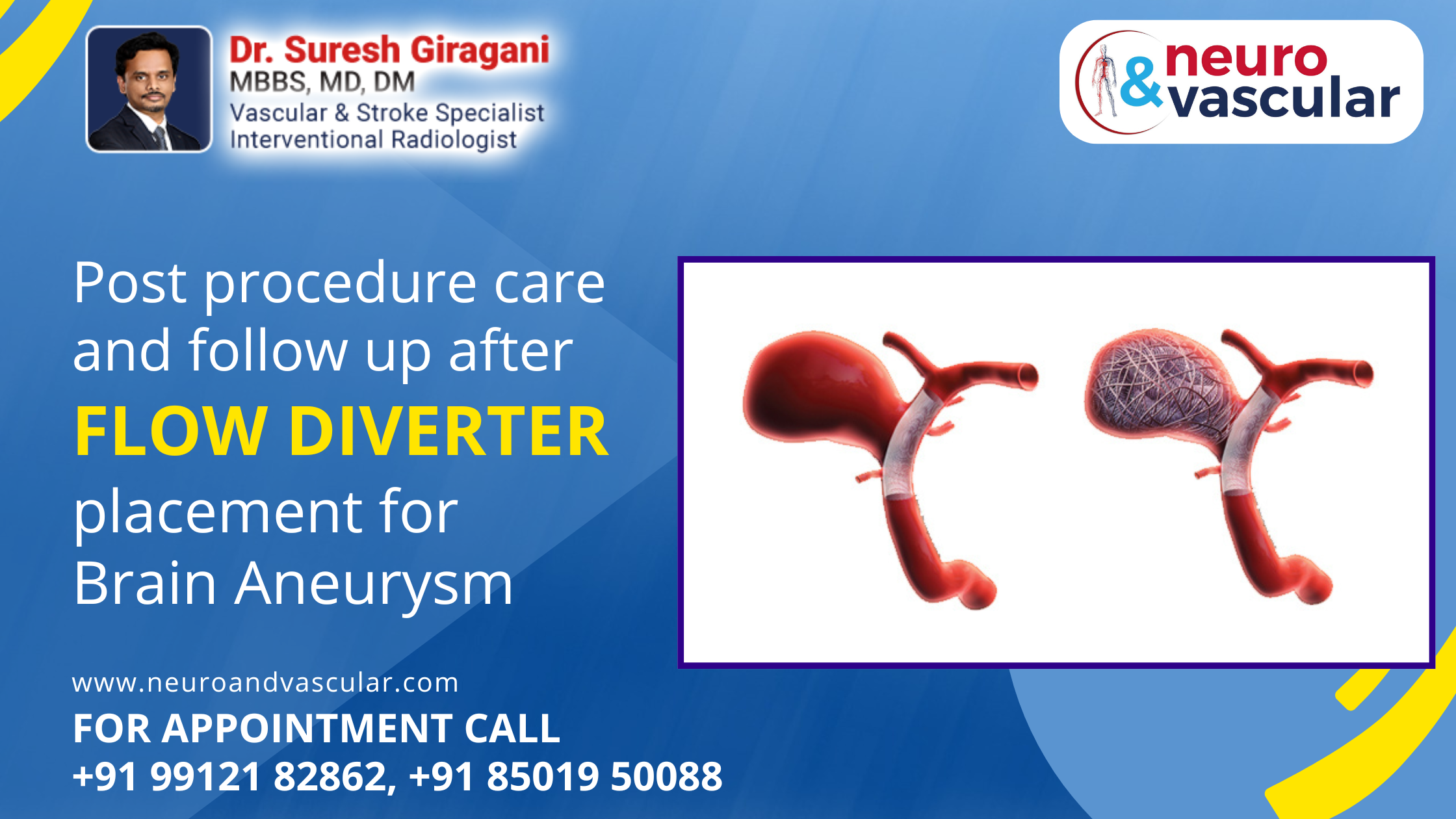
Post procedure care and follow up after flow diverter placement for brain aneurysm

Flow diverter placement has revolutionized the treatment of complex intracranial aneurysms, offering a minimally invasive approach that promotes the healing and reconstruction of blood vessels. However, successful outcomes rely not only on the procedure itself but also on diligent post-procedure care and comprehensive follow-up. In this blog post, we’ll explore the essential aspects of post-procedure care and the importance of regular follow-up after flow diverter placement.
Immediate Post-Procedure Care:
Following flow diverter placement, patients are typically monitored closely in a hospital setting to ensure immediate post-procedure recovery and detect any potential complications. Immediate post-procedure care may include:
- Monitoring Vital Signs: Continuous monitoring of vital signs such as blood pressure, heart rate, and oxygen saturation helps early detection of any signs of complications such as bleeding or thrombosis.
- Neurological Assessment: Regular neurological assessments are conducted to evaluate cognitive function, motor skills, and sensation, ensuring that there are no neurological deficits following the procedure.
- Pain Management: Patients may experience mild to moderate discomfort or headache after flow diverter placement. Pain management strategies such as analgesic medications or supportive measures are employed to alleviate symptoms and enhance comfort.
- Fluid and Nutrition Management: Adequate hydration and nutrition are essential for promoting healing and recovery. Patients may receive intravenous fluids and dietary support as needed during the immediate post-procedure period.
- Early Mobilization: Encouraging early mobilization and ambulation helps prevent complications such as deep vein thrombosis (DVT) and facilitates faster recovery.
- Patient Education: Patients and their caregivers receive comprehensive education about post-procedure care, including activity restrictions, signs of potential complications, and follow-up appointments.
Post-Procedure Recovery at Home:
Once discharged from the hospital, patients continue their recovery journey at home with ongoing support from healthcare providers and caregivers. Key aspects of post-procedure recovery at home include:
- Activity Restrictions: Patients are advised to avoid strenuous activities, heavy lifting, or vigorous exercise for a certain period following flow diverter placement. Gradual resumption of normal activities is encouraged under the guidance of healthcare providers.
- Medication Adherence: Compliance with prescribed medications, including antiplatelet agents or anticoagulants, is crucial to prevent thrombotic complications and promote optimal healing of the flow diverter.
- Wound Care: Patients are instructed on proper wound care techniques, including keeping the incision site clean and dry, monitoring for signs of infection, and contacting healthcare providers if any concerns arise.
- Symptom Management: Patients are educated about common symptoms they may experience during the recovery period, such as headache, dizziness, or fatigue, and provided with guidance on symptom management strategies.
- Follow-Up Appointments: Regular follow-up appointments with neurovascular specialist in Hyderabad are scheduled to monitor progress, assess the patency of the flow diverter, and address any concerns or complications that may arise.
Importance of Follow-Up:
Regular follow-up appointments are essential for ensuring the long-term success and durability of flow diverter placement. These appointments serve several important purposes:
- Assessment of Flow Diverter Patency: Follow-up imaging studies such as angiography or magnetic resonance angiography (MRA) are performed to evaluate the integrity and patency of the flow diverter and assess the degree of aneurysm occlusion.
- Detection of Complications: Follow-up appointments allow healthcare providers to monitor for potential complications such as stent thrombosis, in-stent stenosis, or aneurysm recurrence and intervene promptly if needed.
- Adjustment of Medications: Medication regimens, including antiplatelet therapy or anticoagulation, may be adjusted based on the patient’s response and risk of thrombotic or hemorrhagic complications.
- Patient Education and Support: Follow-up appointments provide an opportunity for ongoing patient education, counseling, and support, addressing any questions or concerns the patient may have and promoting adherence to post-procedure recommendations.
- Long-Term Monitoring: Flow diverter placement is a long-term solution for treating intracranial aneurysms, and regular follow-up allows for continuous monitoring of the patient’s vascular health and overall well-being over time.
Conclusion:
Post-procedure care and follow-up are integral components of the treatment journey for patients undergoing flow diverter placement. By adhering to post-procedure recommendations, attending regular follow-up appointments, and maintaining open communication with healthcare providers, patients can optimize their recovery, minimize complications, and achieve favorable long-term outcomes. Nurturing recovery requires a collaborative effort between patients, caregivers, and healthcare providers, ensuring comprehensive support and guidance throughout the post-procedure recovery process.
About the Author:

Name: DR . SURESH GIRAGANI
INTERVENTIONAL RADIOLOGIST
DR. SURESH GIRAGANI CONSULTANT INTERVENTIONAL RADIOLOGIST at Apollo hospitals Jubilee Hills has more than sixteen years of clinical experience in vascular interventions with a special interest in neurovascular and peripheral vascular disease interventional procedures.